
JunOS_2_routingessentials
.pdf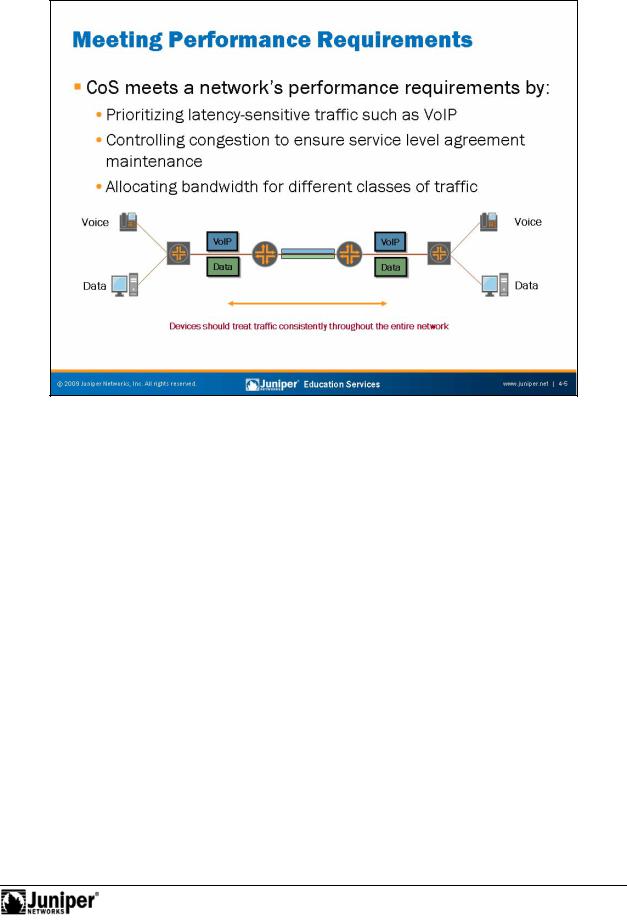
Not
JUNOS Routing Essentials
Meeting the quir m nts
You can use CoS to control the order in which traffic is forwarded through devices
running JUNOS Software. Even in networks that are not fully utilizing the capacity on |
||
all their netwo k links, instantaneous contention for transmission to the wire can |
||
ccur. If two packetsReproductionarrive at an output interface at the same time, the system |
||
transmits |
ne packet and adds the other to a queue. The delay in the queue might be |
|
minimal in a generally uncongested network; however, even a brief delay can be |
||
significant |
|
latency-sensitive traffic (such as voice over IP [VoIP]). You can use traffic |
for |
|
|
prioritization to ensure that latency-sensitive traffic transmits before other traffic. Prioritization also controls the way that extra bandwidth is allocated after all bandwidth guarantees have been met.
Most devices running JUNOS Software use the random early detection (RED) algorithm to avoid congestion. The device uses the RED algorithm to selectively drop random packets before congestion becomes critical. This process should cause affected TCP sessions to go into slow-start mode, reducing the total amount of traffic clients attempt to transmit through the congested link. Because of the algorithm used, higher-bandwidth data streams are the most likely to be affected, while lower-bandwidth streams (including most interactive sessions) are the least likely to be affected.
You can also configure devices running JUNOS Software to guarantee certain levels of bandwidth to traffic classes. This configuration ensures that the device meets minimum bandwidth guarantees during periods of congestion. In this way, it is possible to ensure that certain types of traffic receive a guaranteed minimum level of bandwidth on each link.
Class of Service • Chapter 4–5

JUNOS Routing Essentials
Forwarding ClassesReproduction
A forwarding class is an abstract concep devices running JUNOS Software use to identify traffic that should receive common treatment. The device associates traffic with a forwardingforclass during the classification process. During output, the system assigns traffic to a pa ticular output queue based on forwarding class and rewrites behavior aggregate markers based on forwarding class.
NotIt is emp ing, and sometimes helpful, to think of forwarding classes as output queues because a one-to-one mapping of forwarding classes and output queues usually exists. H wever, that definition is not necessarily true, because some platforms
supp rt more forwarding classes than queues. In these cases, combining the concepts of forwarding classes and output queues can be confusing.
Chapter 4–6 • Class of Service
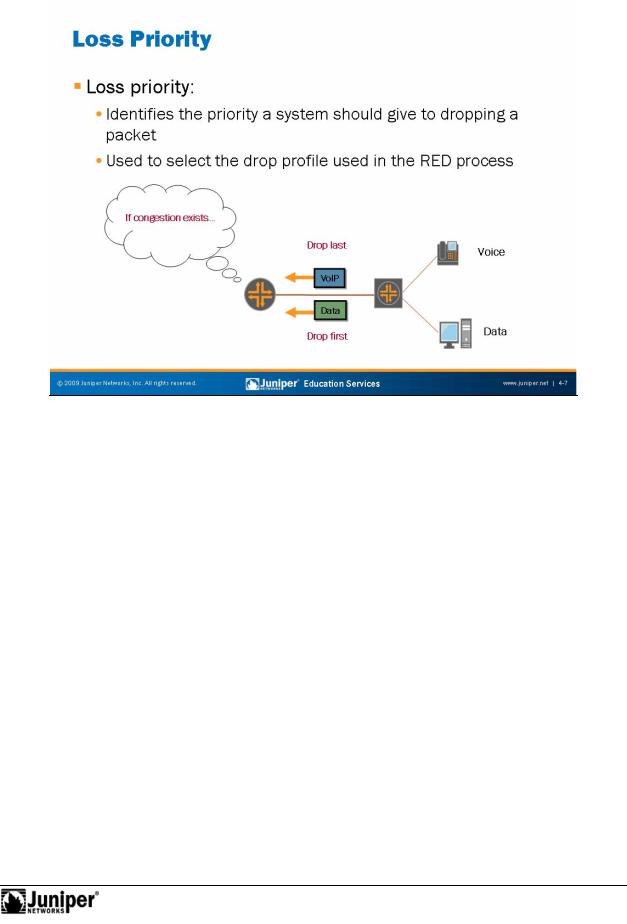
JUNOS Routing Essentials
|
C nfigu ing REDReproductionin this way is beyond the scope of this class. |
|
|
|
|
|
|||
|
Loss Priority |
|
|
|
|
You can associate a loss priority with a packet to tell the system what priority it should |
|||
|
for |
. If you choose to configure RED, you |
||
|
give to d opping this packet during conges |
|||
|
can choose different drop probabilities for traffic with different loss priorities. |
|||
|
Not |
|
|
|
Class of Service • Chapter 4–7
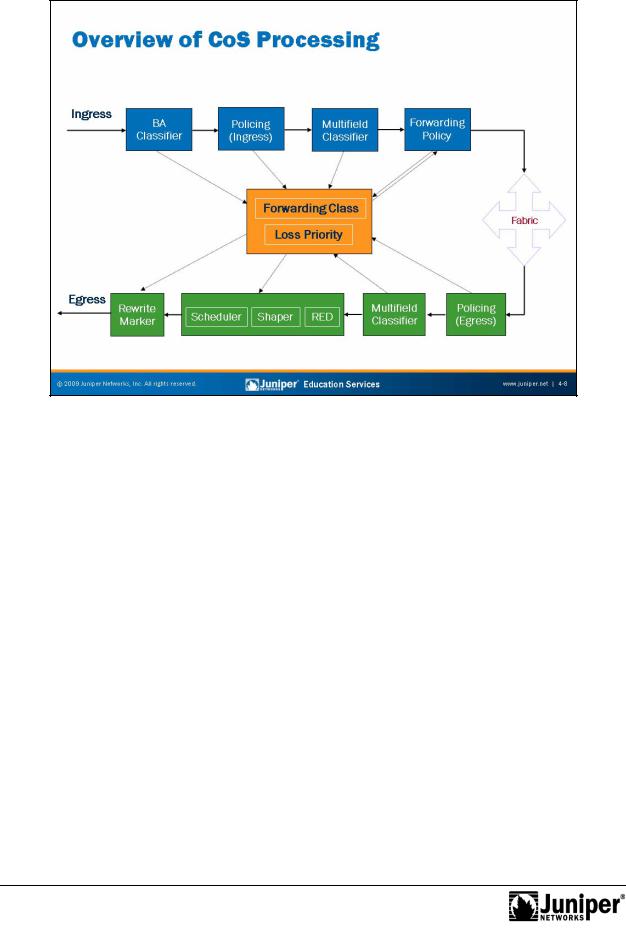
JUNOS Routing Essentials
The chart on the slide Reproductionprovides an overview of the way that CoS processing occurs in the JUNOS Softwa e. The arrowheads indicate the flow of information. Thus, if a
process sets the wa ding class and loss priority, the arrow points towards the forwardingforclass and loss priority box. If the process uses the forwarding class and
loss priority as input values, the arrow points away from the forwarding class and loss Notpriori y b x.
Y u can configure devices running JUNOS Software to set the forwarding class and
l ss pri rity for a given packet based on the values of certain header fields, including DiffServ code point (DSCP), IP precedence, MPLS EXP, and IEEE 802.1p. Edge devices usually set these fields, which indicate the category of traffic. In this way, a device in the core does not need to recategorize traffic it receives from an edge device.
Because these fields indicate the category of traffic to which the packet belongs, we refer to this kind of classification as a behavior aggregate (BA) classifier.
You can also configure JUNOS devices to set the forwarding class and loss priority with multifield classifiers on both ingress and egress. You implement multifield classifiers using firewall filters. Multifield classifiers allow you to select packets using all the selection criteria of a firewall filter and set the forwarding class and loss priority within the then clause. You can also use ingress and egress policers to modify the forwarding class and loss priority.
Continued on next page.
Chapter 4–8 • Class of Service

JUNOS Routing Essentials
CoS Processing (contd.)
You can use forwarding policy options to implement CoS-based forwarding. When multiple equal-cost paths to a destination exist, you can use CoS-based forwarding to specify which of the equal-cost paths to use for different classes of traffic. Additionally, you can use forwarding policy options to reset the forwarding class and loss priority for packets destined for particular prefixes.
Devices running JUNOS Software use the forwarding class and loss priority on egress to assign traffic to queues, implement the RED algorithm, and rewrite BA headers.
Note that CoS support varies between platforms running JUNOS Software. For detailed support information, consult the documentation for your specific platform.
|
for |
Reproduction |
Not |
|
|
|
|
Class of Service • Chapter 4–9
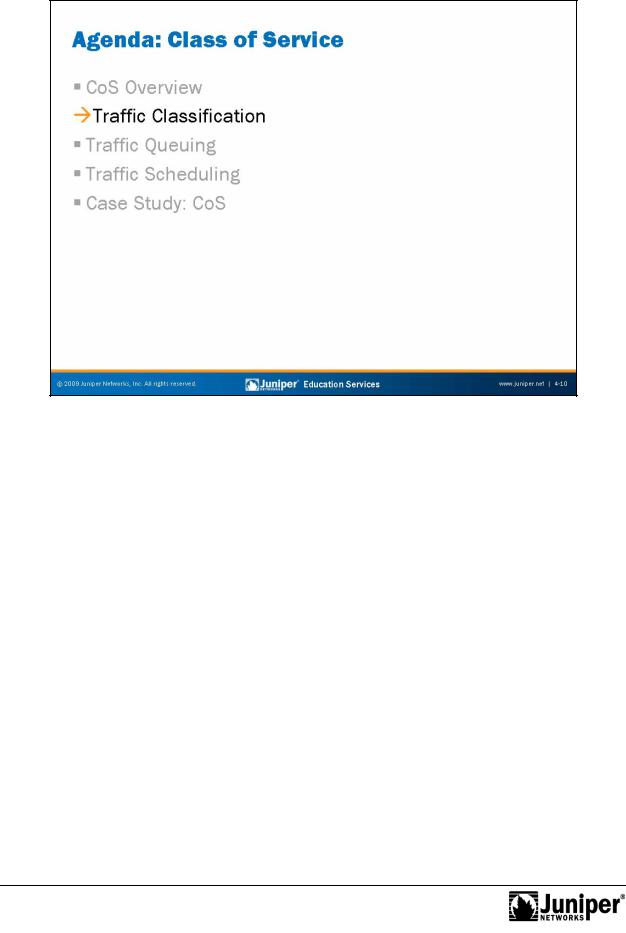
JUNOS Routing Essentials
|
|
Reproduction |
Traffic Classification |
||
The slide highlights the topic we discuss next. |
||
Not |
for |
|
|
|
|
Chapter 4–10 • Class of Service
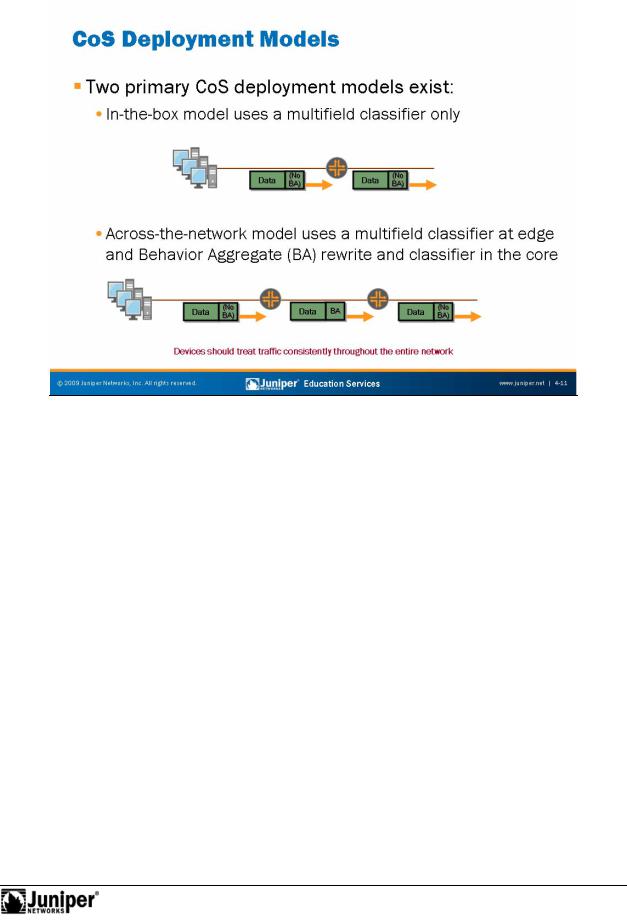
JUNOS Routing Essentials
|
netw k. |
Reproduction |
|
|
|
|
|||
|
CoS Deploym nt Mod ls |
|||
|
Two models for CoS deployment exist. In some networks, the only use for CoS is to |
|||
|
for |
|||
|
provide diffe entiated forwarding services through a single device. In other networks, |
|||
|
the CoS deployment provides differentiated services across multiple devices within a |
|||
|
With a depl |
yment limited to a single device, the system typically classifies packets as |
||
|
Not |
|
|
|
hey pass through using a multifield classifier, then uses the classification to provide he configured service level, and forwards the packets without any BA markings (DSCP, IP precedence, and so forth). However, when the deployment crosses multiple devices, the classification usually occurs differently.
When you configure multiple devices in a network to use CoS to provide differentiated services, it is usually beneficial to initially perform the classification on the edge device and then transmit that classification within the network using a BA. In this model, the edge device classifies traffic using a multifield classifier as traffic enters the network. When the edge device transmits the packet into the network, it marks the packets with a BA. The remainder of the devices in the network read the BA and automatically set the correct forwarding class and loss priority without a multifield classifier.
Continued on next page.
Class of Service • Chapter 4–11

JUNOS Routing Essentials
CoS Deployment Models (contd.)
Using BAs in network-wide CoS applications provides several advantages. First, it ensures consistent CoS treatment of the traffic throughout the network. Second, it simplifies the task of creating and maintaining accurate multifield classifiers on each system. Without BAs, each device must have a multifield classifier capable of classifying all traffic entering the network, and you would need to replicate any classification change on all other devices. Third, in the case of Ethernet, setting the 802.1p bits as a BA allows CoS-aware Ethernet switches to also provide differentiated services to the traffic.
Packets are marked with BAs by setting bits that already exist within the Layer 3 header. Therefore, you do not add additional overhead by setting a Layer 3 BA.
|
for |
Reproduction |
Not |
|
|
|
|
Chapter 4–12 • Class of Service
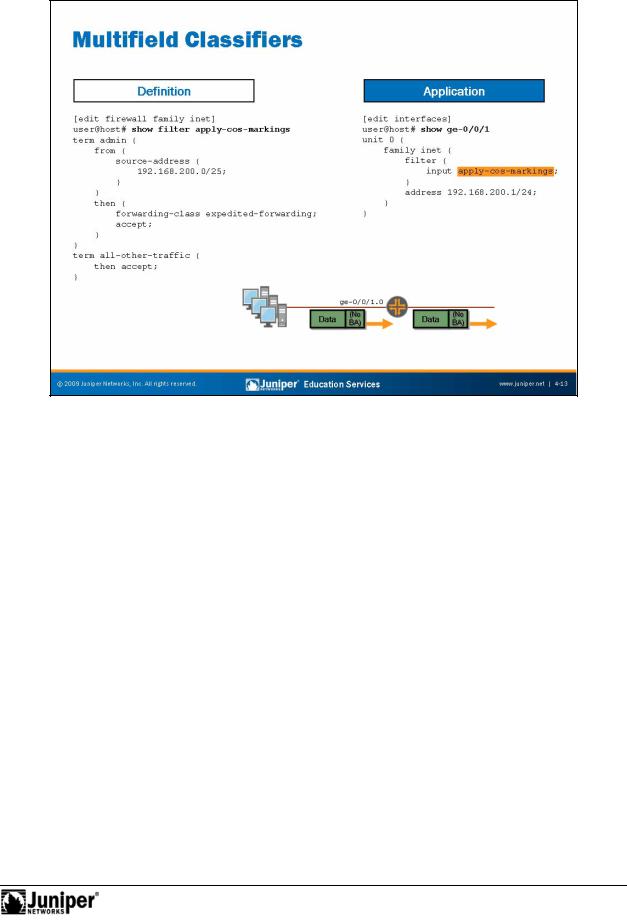
JUNOS Routing Essentials
|
r, if the packetReproductionwas not classified by a BA classifier, the default forwarding class). |
|
Multifield Classifi rs |
|
You configure multifield classifiers just like regular firewall filters. You place the |
forwa |
|
|
ding class and loss priority in the then clause of each term. The default is to not |
|
change the warding class (from the forwarding class assigned by the BA classifier |
|
Because JUNOS devices apply multifield classifiers after BA classifiers, multifield |
Not |
classi iers always override the forwarding class and loss priority assigned by the BA. |
|
|
Class of Service • Chapter 4–13
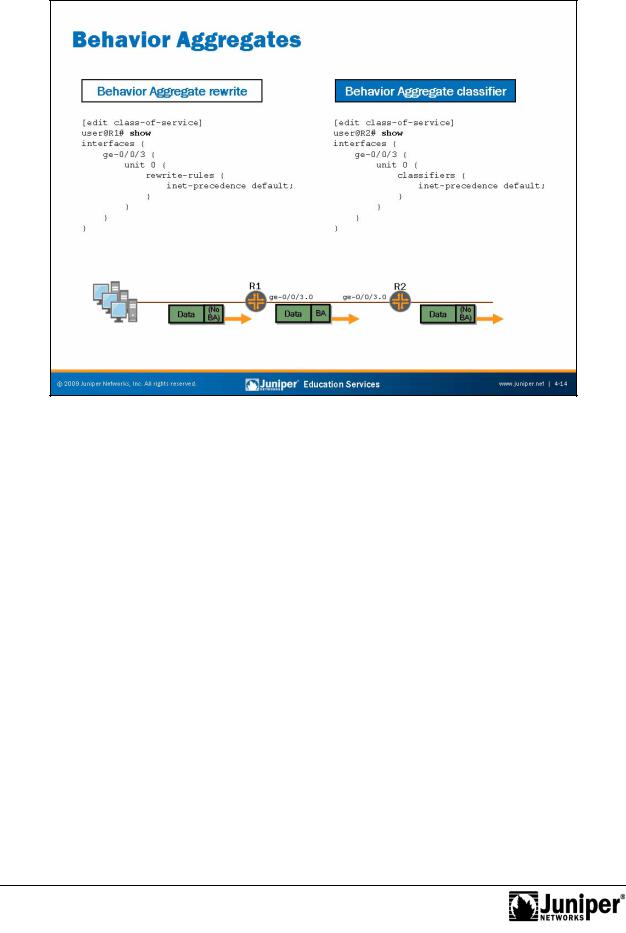
JUNOS Routing Essentials
Behavior AggregatesReproduction
You configure JUNOS devices to apply BA markers to packets leaving an interface by applyingfora rew ite ule to the outbound interface. By default, JUNOS does not modify a packet’s Layer 3 BA header fields as it is sent through the device, so it is only necessary to set these fields once, usually the device at the edge of the network. However, the s tware does not preserve Layer 2 fields (such as the MPLS EXP and IEEE 802.1p ields), so you must configure the system to reapply Layer 2 BA header
Notfields on every appropriate interface as a packet traverses the network.
Y u apply rewrite rules under the [edit class-of-service interfaces] hierarchy. For example, to apply the default IP precedence markings, type set interface-name unit logical-unit-number rewrite-rules inet-precedence default. You can apply rewrite rules at both Layer 2 and Layer 3; however, you cannot apply both IP precedence and DSCP rules to the same packets, because they use the same bits in the IP header.
Continued on next page.
Chapter 4–14 • Class of Service
